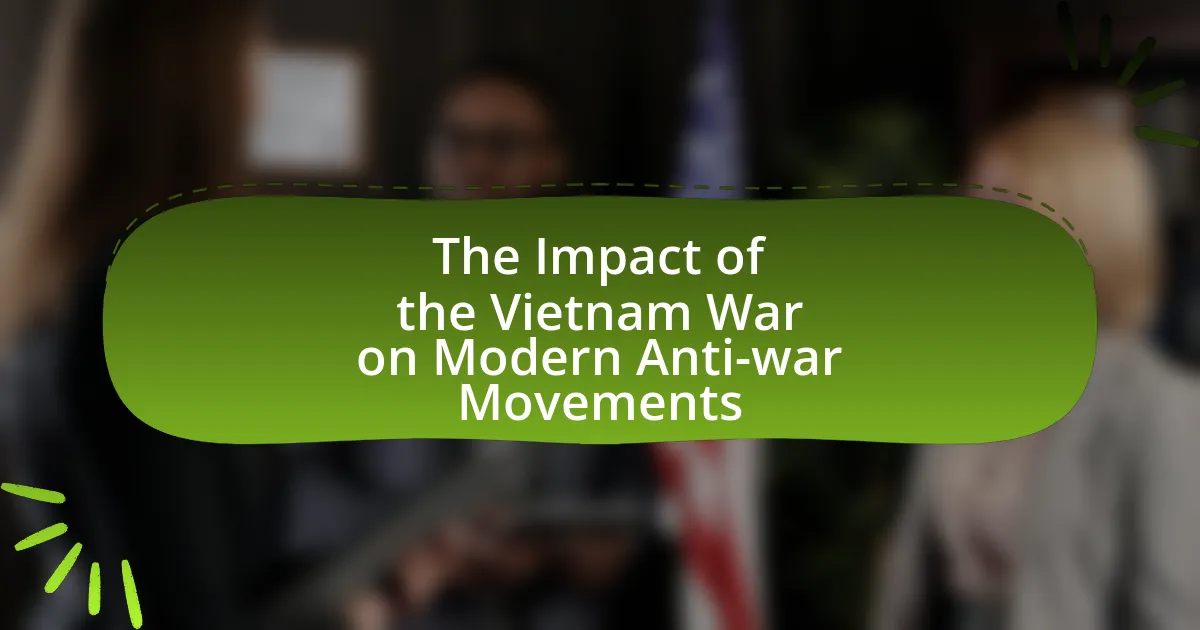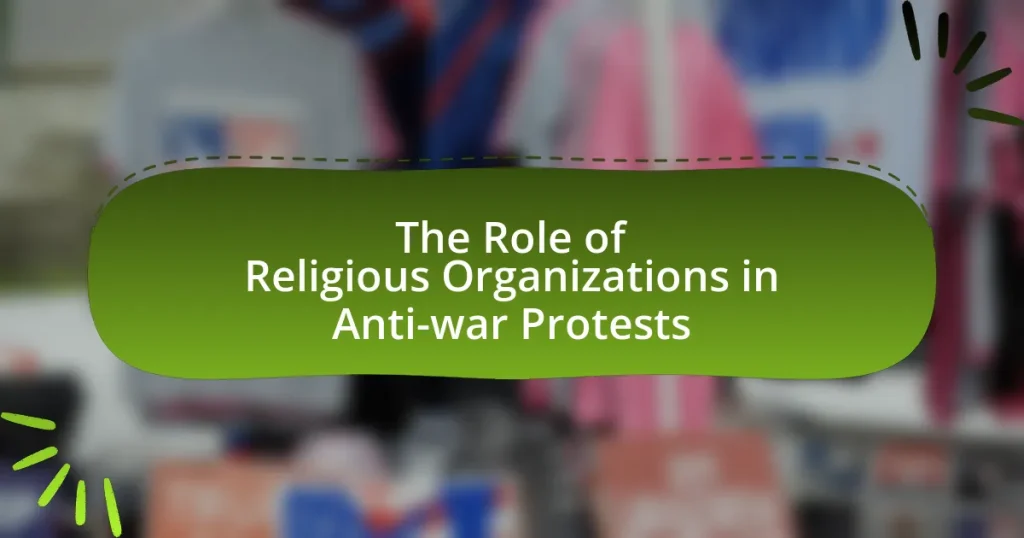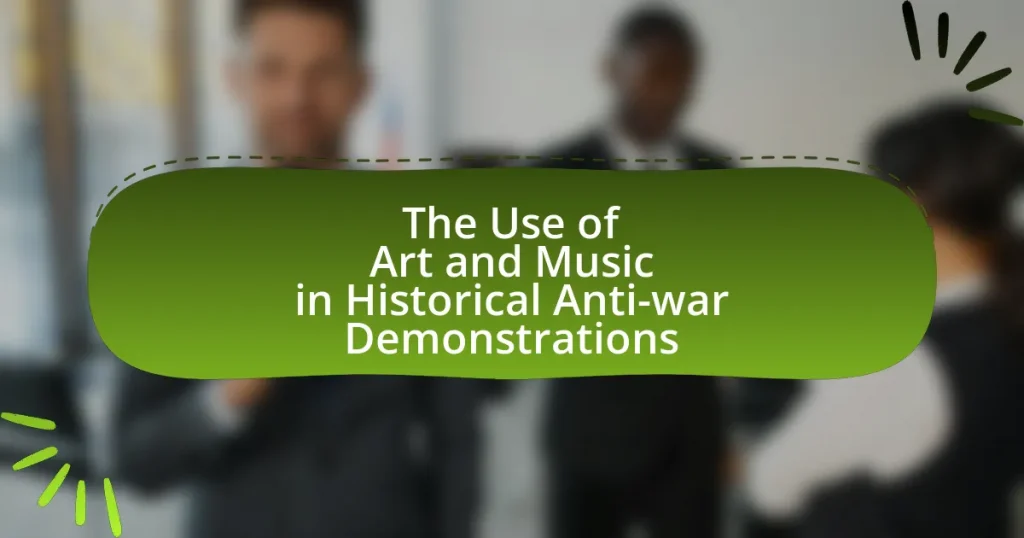The article examines the profound impact of the Vietnam War on modern anti-war movements, highlighting how it established a framework for public dissent and activism against military conflicts. It discusses the evolution of public perception regarding war, influenced by key events and graphic media coverage, which shifted sentiment from support to skepticism. The article also explores the rise of organized anti-war movements during the Vietnam War era, the role of grassroots activism, and the strategies that contemporary movements have adopted, including the use of social media. Additionally, it addresses the lessons learned from the Vietnam War that continue to resonate in today’s anti-war activism, emphasizing the importance of public opinion, media engagement, and collective action in advocating for peace and social justice.
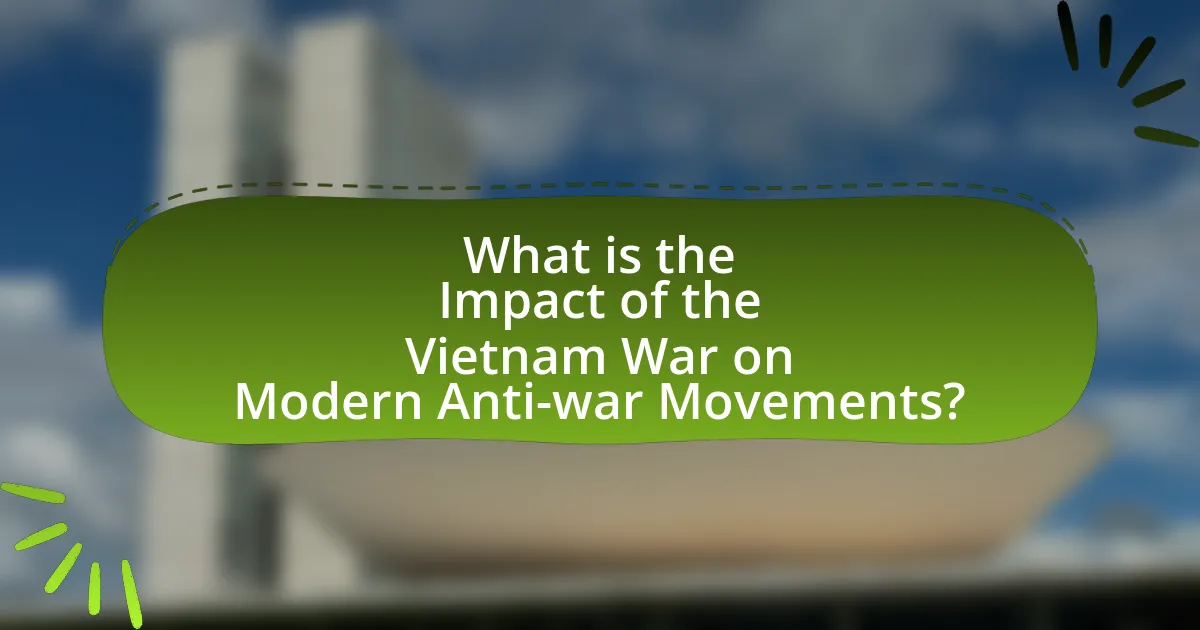
What is the Impact of the Vietnam War on Modern Anti-war Movements?
The Vietnam War significantly shaped modern anti-war movements by establishing a framework for public dissent and activism against military conflicts. The widespread protests during the Vietnam War, particularly in the United States, highlighted the power of grassroots organizing and media coverage in mobilizing public opinion against government policies. This historical context laid the groundwork for contemporary movements, such as those opposing the Iraq and Afghanistan wars, which similarly utilize social media and public demonstrations to voice dissent. The legacy of the Vietnam War also includes a heightened awareness of the moral implications of war, influencing activists to advocate for peace and social justice in a more interconnected global landscape.
How did the Vietnam War shape public perception of war?
The Vietnam War significantly altered public perception of war by exposing the brutal realities of combat and the consequences of military intervention. Graphic media coverage, including televised images of casualties and protests, shifted public sentiment from support to skepticism regarding U.S. involvement in foreign conflicts. This shift is evidenced by the decline in approval ratings for the war, which dropped from 61% in 1965 to 26% by 1971, as reported by Gallup polls. The disillusionment fostered by the Vietnam War laid the groundwork for modern anti-war movements, emphasizing the importance of public opinion in shaping military policy and the ethical considerations surrounding warfare.
What were the key events during the Vietnam War that influenced public opinion?
Key events during the Vietnam War that influenced public opinion include the Tet Offensive in 1968, the My Lai Massacre in 1968, and the release of the Pentagon Papers in 1971. The Tet Offensive, a large-scale surprise attack by North Vietnamese forces, contradicted U.S. government claims of imminent victory, leading to widespread disillusionment among the American public. The My Lai Massacre, where U.S. troops killed hundreds of unarmed Vietnamese civilians, sparked outrage and intensified anti-war sentiment. The Pentagon Papers revealed that the government had misled the public about the war’s progress and rationale, further eroding trust in government and fueling protests. These events collectively shifted public perception, contributing to the growing anti-war movement.
How did media coverage of the Vietnam War affect anti-war sentiments?
Media coverage of the Vietnam War significantly heightened anti-war sentiments among the American public. Graphic images and reports of casualties, such as the Tet Offensive in 1968, brought the brutal realities of the conflict into living rooms across the nation, leading to widespread outrage and protests. The broadcast of the My Lai Massacre in 1969, where hundreds of unarmed Vietnamese civilians were killed by U.S. soldiers, further galvanized opposition to the war, as it starkly contradicted government narratives about the war’s progress and morality. This shift in perception was evidenced by a Gallup poll in 1971, which indicated that 61% of Americans believed the war was a mistake, reflecting a direct correlation between media portrayals and public sentiment.
Why did the Vietnam War lead to the rise of organized anti-war movements?
The Vietnam War led to the rise of organized anti-war movements primarily due to widespread public discontent with U.S. involvement in a conflict perceived as unjust and costly. As the war escalated, graphic media coverage revealed the harsh realities of combat, including civilian casualties, which fueled outrage among citizens. This discontent was further amplified by the draft, which disproportionately affected young men from lower socioeconomic backgrounds, leading to protests and mobilization efforts across the country. Notably, events such as the Kent State shootings in 1970 galvanized public sentiment, resulting in large-scale demonstrations and the formation of various anti-war organizations, such as Students for a Democratic Society and the Vietnam Veterans Against the War. These movements were characterized by their ability to unify diverse groups, including students, veterans, and civil rights activists, all advocating for an end to U.S. military involvement in Vietnam.
What were the main organizations formed during the Vietnam War era?
The main organizations formed during the Vietnam War era include the Students for a Democratic Society (SDS), the Vietnam Veterans Against the War (VVAW), and the National Mobilization Committee to End the War in Vietnam. SDS, established in 1960, played a crucial role in mobilizing college students against the war, advocating for civil rights and social justice. VVAW, founded in 1967, consisted of veterans who opposed the war and sought to raise awareness about its consequences. The National Mobilization Committee, formed in 1969, organized large-scale protests and demonstrations, including the significant Moratorium to End the War in Vietnam. These organizations collectively influenced public opinion and contributed to the anti-war movement’s momentum during the Vietnam War era.
How did grassroots activism evolve during the Vietnam War?
Grassroots activism evolved significantly during the Vietnam War as it transitioned from small, localized efforts to a widespread, organized movement. Initially, activism was primarily driven by college students and local peace groups, but as the war escalated, it gained momentum through larger coalitions such as the Students for a Democratic Society (SDS) and the Vietnam Veterans Against the War (VVAW). These organizations mobilized mass protests, including the notable 1969 Moratorium to End the War in Vietnam, which drew millions of participants nationwide. The evolution was marked by increased public awareness and engagement, fueled by media coverage of the war’s brutality, leading to a more diverse coalition of activists, including civil rights groups and religious organizations. This shift in grassroots activism laid the groundwork for future anti-war movements, demonstrating the power of collective action in influencing public policy and opinion.
What lessons from the Vietnam War are relevant to today’s anti-war movements?
The lessons from the Vietnam War that are relevant to today’s anti-war movements include the importance of public opinion, the role of media, and the impact of grassroots activism. Public opposition to the Vietnam War significantly influenced U.S. policy, demonstrating that widespread dissent can lead to changes in government actions. The media’s coverage of the war, particularly graphic images and reports, played a crucial role in shaping public perception and mobilizing protests, highlighting the power of information dissemination in modern conflicts. Additionally, grassroots movements, such as those organized by veterans and students, showcased the effectiveness of collective action and community engagement in advocating for peace. These elements underscore the necessity for contemporary anti-war movements to leverage public sentiment, utilize media strategically, and foster grassroots participation to achieve their goals.
How have modern anti-war movements adopted strategies from the Vietnam War era?
Modern anti-war movements have adopted strategies from the Vietnam War era by utilizing grassroots organizing, mass protests, and media engagement to mobilize public opinion against military interventions. For instance, contemporary movements often mirror the Vietnam-era tactics of large-scale demonstrations, such as the 2003 protests against the Iraq War, which drew millions globally, reminiscent of the 1960s and 1970s protests against the Vietnam War. Additionally, the use of social media platforms today parallels the Vietnam War era’s reliance on print and broadcast media to disseminate anti-war messages, allowing for rapid information sharing and community building. This strategic continuity highlights the effectiveness of these methods in shaping public discourse and influencing policy decisions regarding military actions.
What specific tactics used during the Vietnam War are still effective today?
Guerrilla warfare tactics, psychological operations, and grassroots mobilization used during the Vietnam War remain effective today. Guerrilla warfare, characterized by small, mobile groups engaging in hit-and-run tactics, is still employed by various insurgent groups worldwide, demonstrating its adaptability in asymmetric warfare. Psychological operations, which aimed to influence public perception and morale, continue to be utilized in modern conflicts to sway opinions and undermine enemy resolve. Grassroots mobilization, exemplified by large-scale protests and community organizing during the Vietnam War, has proven effective in contemporary anti-war movements, as seen in recent demonstrations against military interventions, highlighting the enduring power of collective action in shaping public discourse and policy.
How do contemporary movements address issues of war and peace differently?
Contemporary movements address issues of war and peace differently by emphasizing grassroots activism, digital mobilization, and intersectionality. Unlike earlier movements, which often focused solely on anti-war rhetoric, modern movements leverage social media platforms to organize protests, disseminate information, and build coalitions across various social justice issues. For instance, the Black Lives Matter movement incorporates anti-war sentiments by linking militarization of police to broader systemic violence, demonstrating a holistic approach to peace that includes social equity. Additionally, research from the Institute for Policy Studies highlights that contemporary movements prioritize inclusivity and diverse voices, reflecting a shift from singular narratives to multifaceted perspectives on conflict and resolution.
What role does social media play in modern anti-war activism?
Social media serves as a crucial platform for modern anti-war activism by facilitating rapid information dissemination and mobilizing grassroots movements. It enables activists to share real-time updates, organize protests, and amplify their messages to a global audience, significantly increasing visibility and engagement. For instance, during the Iraq War, platforms like Twitter and Facebook were instrumental in coordinating protests and sharing personal narratives, which helped to shape public opinion against the war. Additionally, studies have shown that social media campaigns can lead to increased participation in anti-war activities, as seen in the #NoWar movement, which gained traction through viral posts and online petitions.
How has social media changed the landscape of protest and activism?
Social media has transformed the landscape of protest and activism by enabling rapid communication, mobilization, and the dissemination of information. Platforms like Twitter and Facebook allow activists to organize events, share real-time updates, and amplify their messages to a global audience, significantly increasing participation and visibility. For instance, the Arab Spring in 2010-2011 showcased how social media facilitated grassroots movements, leading to widespread protests and regime changes in several countries. Additionally, studies indicate that social media can enhance the effectiveness of campaigns by fostering community engagement and solidarity, as seen in movements like Black Lives Matter, which gained momentum through viral hashtags and online activism.
What are the challenges and benefits of using social media for anti-war movements?
Social media presents both challenges and benefits for anti-war movements. One significant benefit is the ability to rapidly disseminate information and mobilize supporters, as seen during the Arab Spring, where platforms like Twitter and Facebook facilitated organization and awareness on a global scale. Conversely, a major challenge is the prevalence of misinformation and the potential for censorship, which can undermine the credibility of the movement and limit its reach. For instance, studies have shown that misinformation can spread six times faster than accurate information on social media, complicating the efforts of anti-war activists to convey their messages effectively.
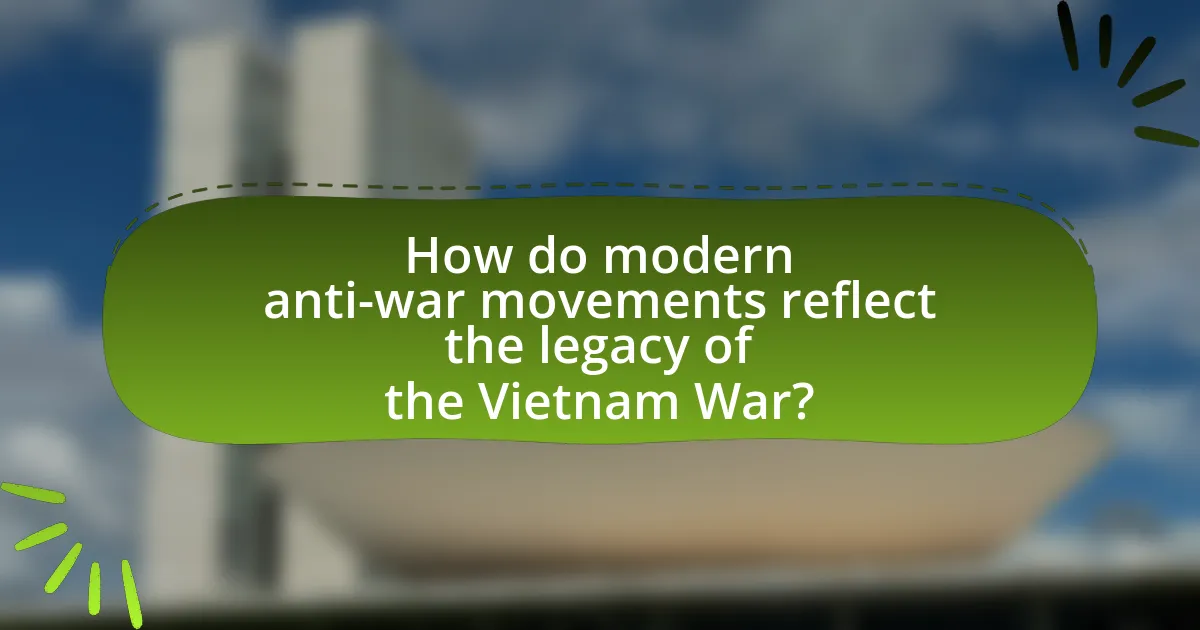
How do modern anti-war movements reflect the legacy of the Vietnam War?
Modern anti-war movements reflect the legacy of the Vietnam War through their emphasis on grassroots activism, public dissent, and the use of digital platforms for mobilization. The Vietnam War catalyzed a shift in public perception regarding military intervention, leading to a more skeptical view of government narratives and military actions. For instance, the widespread protests during the Vietnam War, characterized by significant participation from diverse demographics, established a template for contemporary movements, such as those opposing the Iraq and Afghanistan wars.
Additionally, the Vietnam War’s legacy is evident in the strategies employed by modern activists, who often utilize social media to organize protests and disseminate information rapidly, mirroring the anti-war tactics of the 1960s and 1970s. The anti-war sentiment is further reinforced by historical lessons regarding the human cost of war, as seen in the ongoing discussions about civilian casualties and the ethical implications of military engagement. This continuity highlights how the experiences and lessons from the Vietnam War continue to shape the motivations and methods of current anti-war movements.
What parallels can be drawn between the Vietnam War protests and current conflicts?
Parallels between the Vietnam War protests and current conflicts include widespread public dissent against government military actions and the mobilization of grassroots movements. During the Vietnam War, protests were fueled by disillusionment with U.S. foreign policy and the human cost of war, exemplified by events like the Kent State shootings in 1970, which galvanized public opinion against the war. Similarly, contemporary conflicts, such as the wars in Iraq and Afghanistan, have sparked protests driven by concerns over military intervention, civilian casualties, and the perceived lack of transparency from the government. Both movements utilized similar tactics, including mass demonstrations, social media campaigns, and artistic expressions to convey their messages, highlighting a continuity in anti-war sentiment across generations.
How do current anti-war movements address the lessons learned from the Vietnam War?
Current anti-war movements address the lessons learned from the Vietnam War by emphasizing the importance of grassroots activism and public dissent against military interventions. These movements recognize that widespread public opposition can significantly influence government policy, as evidenced by the massive protests during the Vietnam War that ultimately contributed to the U.S. withdrawal. Additionally, contemporary anti-war activists focus on the consequences of war, such as civilian casualties and long-term societal impacts, drawing parallels to the Vietnam War’s devastating effects on both Vietnamese civilians and American soldiers. This awareness is reflected in campaigns that prioritize diplomacy over military action and advocate for transparency in government decisions regarding war, aiming to prevent the repetition of past mistakes.
What are the key issues that unite modern anti-war activists?
Modern anti-war activists are united by key issues such as opposition to military intervention, advocacy for diplomatic solutions, and a focus on social justice. These activists often emphasize the human and economic costs of war, highlighting statistics that show increased civilian casualties and the financial burden on taxpayers. For instance, studies indicate that military spending diverts funds from essential services like healthcare and education, which are critical for societal well-being. Additionally, activists advocate for the rights of marginalized communities disproportionately affected by war, reinforcing the connection between anti-war sentiments and broader social justice movements.
What practical steps can individuals take to support anti-war movements today?
Individuals can support anti-war movements today by participating in peaceful protests and demonstrations, which have historically been effective in raising awareness and influencing public opinion. Engaging in grassroots organizing, such as forming or joining local activist groups, allows individuals to collaborate on campaigns that advocate for peace and conflict resolution. Additionally, individuals can utilize social media platforms to spread information, share resources, and mobilize support for anti-war initiatives, as seen in various movements that gained traction through online engagement. Supporting organizations that focus on anti-war efforts, such as the American Friends Service Committee or Veterans for Peace, provides financial and volunteer resources that strengthen their impact. Lastly, educating oneself and others about the consequences of war, including its social, economic, and humanitarian impacts, fosters informed discussions that can lead to greater public opposition to military conflicts.
How can individuals engage with local anti-war organizations?
Individuals can engage with local anti-war organizations by attending meetings, volunteering for events, and participating in campaigns. Many organizations hold regular gatherings where community members can discuss issues, share ideas, and plan actions. Volunteering for events such as rallies or educational workshops allows individuals to contribute actively to the cause. Additionally, participating in campaigns, whether through social media outreach or grassroots organizing, helps amplify the message against war. Research indicates that grassroots movements, like those formed during the Vietnam War, have historically been effective in mobilizing public opinion and influencing policy, demonstrating the importance of individual involvement in these organizations.
What resources are available for those looking to educate themselves on anti-war issues?
Numerous resources are available for individuals seeking to educate themselves on anti-war issues, particularly in the context of the Vietnam War’s impact on modern movements. Key resources include books such as “The Vietnam War: A History” by Stanley Karnow, which provides a comprehensive overview of the war and its implications, and “A People’s History of the Vietnam War” by Jonathan Neale, which offers insights into grassroots anti-war activism. Additionally, organizations like the American Friends Service Committee and Veterans for Peace provide educational materials, workshops, and online resources focused on anti-war advocacy. Academic journals such as “Peace & Change” and “The Journal of Peace Research” publish research articles that analyze anti-war movements and their historical contexts, including the Vietnam War. These resources collectively contribute to a deeper understanding of anti-war issues and the evolution of activism in response to military conflicts.
